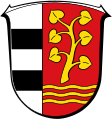Isenburg (noble family)
|
Territory in the Holy Roman Empire |
|
|---|---|
| County of Nieder-Isenburg County / Principality of Isenburg |
|
| coat of arms | |
 
|
|
| map | |

|
|
| Grafschaft Isenburg (pink, right) and Nieder-Isenburg (pink, center left) around 1400 | |
| Alternative names | Ysenburg |
| Form of rule | monarchy |
| Ruler / government | Graf , Isenburg-Birstein from 1744: Prince |
| Today's region / s | DE-RP , DE-HE |
| Parliament | Reichsfürstenrat from 1803: 1 curial vote on the Wetterauische Count Bank for Isenburg , 1 on the westf. Bank for Nieder-Isenburg (until 1644) |
| Reichskreis |
Ober-Isenburg: Upper Rhine Nieder-I .: Kurheinisch |
| Capitals / residences |
Nieder-Isenburg: Isenburg , Arenfels , Limburg , Grenzau , Ober-Isenburg: Büdingen , Ronneburg , Birstein , Offenbach Büdinger special lines (from 1787): Büdingen , Marienborn , Meerholz , Wächtersbach |
| Denomination / Religions | reformed |
| Language / n |
Nieder-Isenburg: German Moselle Franconian Upper Isenburg: German Rhine Franconian |
| surface | 190 km² (around 1800) |
| Residents | 58,000 (around 1800) |
| Incorporated into |
Nieder-Isenburg : 1664 Condominium from Walderdorff and Wied Ober-Isenburg: 1815 Austria , 1816 Grand Duchy of Hesse and parts of Kurhessen
|
The noble family Isenburg, also Ysenburg , is a high noble family whose origins date to the 11th century. Ancestral seat of the family was Isenburg near Isenburg (Westerwald) in today's Neuwied district . By 1376 the Ysenburgers succeeded in asserting the claims they had acquired through marriage to the rule Büdingen (in today's Wetterau district ). His successors were imperial counts in 1442 , including burgraves of Gelnhausen (in today's Main-Kinzig district ).
The county of Isenburg (until 1744 Isenburg or Ysenburg , then only the Birsteiner line with "I") reached its greatest expansion in the 18th century. It comprised parts of what is now the Main-Kinzig district and Wetterau district in the northern part and the district and the city of Offenbach in the southern part.
The Isenburg-Limburg and Isenburg-Kempenich lines , which were founded by Rembold von Isenburg , branched out several times (Nieder-Isenburg). By marriage, Ysenburger acquired the rule of Büdingen and other areas in the southeastern Wetterau (Ober-Isenburg). As counts and princes directly under the empire , the various lines of the Isenburg / Ysenburger belonged to the high nobility.
history
Nieder-Isenburg
The Isenburg people were considered to be one of the most important, long-established, noble-free families on the Middle Rhine and in the Westerwald . The first verifiable permanent residence of the family was a manor in Rommersdorf, near today's Heimbach-Weis , a district of Neuwied . Around 1100 the brothers Reinbold (or Rembold ) and Gerlach on Sayn- und Iserbach had built Isenburg Castle and from then on called themselves Lords of Isenburg . Reinbold von Isenburg (1103–1110) was married to a daughter of the penultimate Count von Arnstein and inherited some estates. Further rulership rights were:
- Klostervogtei Fulda
- 1232–1414 Klostervogtei Limburg and rule (see Limburg (noble family) )
- 1326–1462 County of Wied
Gerlach von Isenburg married the heir to the Lords of Kobern at the end of the 12th century. He is referred to as Lord von Kobern in 1189 . Until 1270 the rule of Kobern was in the hands of the Isenburg family.
The branching of the sexes began as early as the 12th century. In 1210 four to five different lines already existed side by side. New family lines were formed, which were accompanied by inheritance divisions. Other castles were built accordingly: Between 1179 and 1210 Braunsberg Castle near Anhausen , 1194 Kobern Castle on the Moselle, Grenzau Castle near Höhr-Grenzhausen in 1213 , Arenfels Castle near Hönningen in 1258/59 .
In the 13th century Bruno von Braunsberg and his brother Dietrich von Isenburg inherited half of the County of Wied . Later succeeded Wilhelm von Braunsberg-Isenburg (1324-1383) to unite the entire county and to found a new line of the Counts of Wied.
At the end of the 15th century, only the Isenburg-Büdingen branch was left of the Isenburg-Limburg line . This new county divided several times from the end of the 15th century to the middle of the 17th century.
With the death of Count Ernst von Isenburg-Grenzau in 1664, the Nieder-Isenburg line became extinct. From 1666, the Counts of Walderdorff and Counts of Wied-Neuwied became rulers as part of a condominium .
Ober-Isenburg
Ludwig von Isenburg († around 1304), a Ysenburger (from Nieder-Isenburg ), probably came to the southeastern Wetterau (Ober-Isenburg) through a marriage with the heiress of Büdingen . The Ysenburgers succeeded in acquiring most of the Büdingen inheritance, which had originally split into five parts, including the administration of the Büdinger Forest as part of the Gelnhausen Palatinate , over the course of 150 years.
This county of Isenburg-Büdingen with Büdinger Castle as the center of power was divided into the Isenburg-Ronneburg and Isenburg-Birstein lines ( first main division ) in 1511/17 . The Isenburg-Ronneburg line died out in 1601 , after which the entire ownership fell to Isenburg-Birstein. The Isenburg-Birstein line split into the Isenburg-Büdingen and Isenburg-Offenbach branches ( second main division ) in 1628/31 .
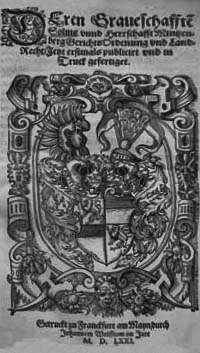
At the end of the 16th century, the Solms land law was introduced as state law in the Isenburg area. A “special act of publication” took place for this. The common law now only applied if the regulations of the Solms land law did not contain any provisions for a matter. The Solms land law remained in force in the parts of the state that fell to the Grand Duchy of Hesse at the beginning of the 19th century . It was only replaced on January 1, 1900 by the civil code that was uniformly applicable throughout the German Empire .
The division of the country in 1687, the creation of the Büdinger Land and the special lines
The third main division (1684) resulted in the two houses Ysenburg-Büdingen-Birstein (from 1744 Principality of Isenburg and Büdingen with residence in Birstein and Offenbach) and Ysenburg-Büdingen (county with residence in Büdingen). The latter divided into four special lines in a new recess (= comparison) in Meerholz on July 23, 1687 . They all called themselves Ysenburg and Büdingen and each added the seat of their line (uniform spelling, however, only from the 19th century): Ysenburg-Büdingen in Büdingen (extinct 1941), Ysenburg-Büdingen in Marienborn (extinct 1725), Ysenburg-Büdingen in Meerholz (extinct in 1929) and Ysenburg-Büdingen in Wächtersbach (which were based in Büdingen in 1941; it was the only special line that was left). The sub-counties were not only connected by consanguinity, but in particular also by house contracts (succession regulations) ( agnates ).
Since the inheritance principle of primogeniture had not yet been introduced in Ysenburg, the territory was divided in 1687 among the four sons of Maria Charlotte (1631–1693), widow of Johann Ernst I von Isenburg-Büdingen, guardian of her sons. The eldest son, Johann Casimir Graf von Isenburg-Büdingen (1660-1693) received the castle , town and court of Büdingen and the surrounding villages, Ferdinand Maximilian, the second oldest son received the castle and town of Wächtersbach , Georg Albrecht received Meerholz and the surrounding villages and Karl August received Marienborn, in today's Büdingen district of Eckartshausen , with the surrounding villages. Since the Ysenburg-Büdingen-Marienborn line soon became extinct, the (new) special lines Ysenburg and Büdingen in Büdingen , Ysenburg and Büdingen in Meerholz and Ysenburg and Büdingen in Wächtersbach were subsequently added to the (older) main Isenburg-Birstein line .
Due to the death of Count Karl August von Ysenburg-Büdingen-Marienborn in 1725, the Marienborn property was divided up according to his will, the offices of Gründau and Eckartshausen, as well as the villages of Gettenbach and Haitz came to Ysenburg-Büdingen-Meerholz.
Each of the now three counties now covered approx. 200 km² with approx. 6,500 inhabitants and an income of approx. 35,000 fl.
Count Wolfgang Ernst I to Isenburg and Büdingen (Birsteiner line) on 23 May 1744 by Emperor Charles VII. In the prince conditions applicable; but it was not until 1803 that his successor received a seat in the Imperial Council of Dukes .
New state in the Confederation of the Rhine - Sovereign Prince
In 1806 the Principality of Isenburg (-Birstein) joined the Rhine Confederation - not entirely voluntarily - and united all the Isenburg lands , including the Ysenburg counties of Büdingen , Meerholz and Wächtersbach. After the de facto dissolution of the Rhine Confederation, the principality was initially occupied enemy territory ( Generalgouvernement Frankfurt ), was then mediatized and came to Austria in 1815 and then in 1816 after it was divided into Hessen-Darmstadt and Hessen-Kassel (the part located south of the Main in today's district and the city of Offenbach and the western part of the part located mostly north of the Kinzig to the Grand Duchy of Hesse , the eastern part of the northern part to the Electorate of Hesse ). In the House of Hesse was from this point on "Prince of Isenburg" part of the title. In the Grand Duchy, the Isenburg sovereign states continued to be organized as the Hesse-Darmstadt District District Offenbach and District District Büdingen and the Hessian part in the Gelnhausen district .
Notable lords in the Grand Duchy of Hesse and in the Electorate of Hesse
Count Ernst Casimir III. von Ysenburg-Büdingen-Büdingen was given the status of Ernst Casimir I by the Grand Duke (Hessen-Darmstadt) in 1840, and Ferdinand Maximilian von Ysenburg-Büdingen-Wächtersbach was raised to the rank of prince by the Elector (Hessen-Kassel) in 1865. The two lines have been called “Princes of Ysenburg and Büdingen” since they were raised to the rank of prince (like the Wächtersbacher line from 1941, after all other lines had died out).
The (Catholic) princely line of Isenburg (-Birstein) and the (evangelical-reformed) princely line of Ysenburg and Büdingen, which belong to the high nobility "second division" as mediatized houses, still exist today . Descendants of the Ysenburg-Philippseich line are the Counts of Büdingen.
Lines

Overview Nieder-Isenburg
- Isenburg, is divided into 1137:
- Isenburg, later Isenburg-Braunsberg, is divided around 1210 into:
- Isenburg-Wied (until 1454, then by marriage to the Lords of Runkel )
- Nieder-Isenburg, is divided into 1502
- Isenburg-Grenzau (1502–1664) ( extinct 1664 )
- Isenburg-Neumagen (1554 by marriage to the Counts of Sayn )
- Isenburg-Kempenich (1197–1424)
-
Isenburg-Limburg (since 1137), divided into 1146
- Isenburg covers (1146-1260)
- Isenburg-Grenzau (since 1146), is divided into 1287
- Isenburg-Arenfels (until 1371, then by marriage to Isenburg-Wied )
- Isenburg-Cleberg, is divided into 1340
- Isenburg-Grenzau (until 1439)
- Isenburg, later Isenburg-Braunsberg, is divided around 1210 into:
Overview Ober-Isenburg
-
Isenburg-Büdingen (since 1340, 1442 imperial count), is divided into 1511:
- Isenburg-Ronneburg (extinct 1601)
-
Isenburg-Birstein (since 1511) is divided into 1628/31:
-
Isenburg-Offenbach (since 1631) is divided into 1685:
- Isenburg-Offenbach (extinct 1718)
-
In 1711 Isenburg-Birstein is divided into:
- Isenburg-Birstein , ruled in 1744, from then on " I senburg", from 1920 from Isenburg (until today), 1806–1815 principality in the Confederation of the Rhine
- Isenburg-Philippseich (until 1920 Counts of Ysenburg and Büdingen in Philippseich )
- Isenburg-Büdingen (since 1628) is divided into 1685:
- Isenburg-Büdingen-Büdingen , since 1840 princes of Ysenburg and Büdingen in Büdingen (until 1941, extinct 1965)
- Isenburg-Wächtersbach , since 1865 (until 1941) princes of Ysenburg and Büdingen in Wächtersbach , from 1941 (until today) princes of Ysenburg and Büdingen
- Isenburg-Meerholz (extinct 1929, until 1929 Counts of Ysenburg and Büdingen in Meerholz )
- Isenburg-Marienborn (extinct 1725)
-
Isenburg-Offenbach (since 1631) is divided into 1685:
Regents
Counts of Isenburg in Büdingen (since 1340)
- 1340–1378 Heinrich II. Von Isenburg in Büdingen , (* around 1300; † 1379) (son of Lothar von Isenburg-Cleeberg, † 1340/41)
- 1378–1395 Johann I von Isenburg in Büdingen , (* around 1325/39, † 1395), (son of Heinrich II. In Büdingen )
- 1395–1408 Johann II. Von Isenburg in Büdingen , (* 1360; † 1408), (son of Johann I in Büdingen )
- 1408–1461 Diether I. von Isenburg in Büdingen , count from 1442, (son of Johann II. Von Isenburg in Büdingen )
- 1461–1511 Ludwig II of Isenburg in Büdingen , (son of Diether I. von Isenburg in Büdingen )
Distribution of inheritance in Counts of Isenburg and Büdingen (Johann V) and until 1601 Count of Ronneburg (Philipp I, then his son Anton von Isenburg-Büdingen-Ronneburg)
Counts of Isenburg and Büdingen zu Ronneburg (1511–1601)
- 1511–1526 Count Philipp von Isenburg-Büdingen-Ronneburg (* 1467, † 1526), (son of Ludwig II. Von Isenburg in Büdingen )
- 1518–1560 Count Anton von Isenburg-Büdingen-Ronneburg (* 1501, † 1560), (son of Philip I of Isenburg-Büdingen-Ronneburg)
- 1560–1566 joint government of the three sons Anton, Georg, Wolfgang and Heinrich, afterwards division:
- 1566–1577 Count Georg von Ysenburg-Ronneburg (* 1528, † 1577), (son of Anton von Isenburg-Büdingen-Ronneburg)
- 1566–1597 in the Kelsterbach region: Count Wolfgang von Ysenburg-Ronneburg (* 1533, † 1597), (son of Anton von Isenburg-Büdingen-Ronneburg)
- 1566–1597 in the Ronneburg part of the country, then throughout the county until his death: Count Heinrich von Ysenburg-Ronneburg (* 1537, † 1601), (son of Anton von Isenburg-Büdingen-Ronneburg)
then falls to Counts of Ysenburg and Büdingen in Birstein
Counts of Isenburg and Büdingen zu Birstein (1511–1633)
- 1511–1533 Count Johann V. von Isenburg (Ysenburg) and Büdingen in Birstein , (son of Ludwig II. Von Isenburg in Büdingen )
- 1533–1596 Count Philipp II of Isenburg-Büdingen in Birstein, (son of Johann V. von Isenburg and Büdingen in Birstein )
- 1596–1633 Count Wolfgang Ernst I of Isenburg-Büdingen in Birstein , Burgrave of Gelnhausen (* 1560; † 1633), (son of Philip II of Isenburg-Büdingen in Birstein )
Division of the estate in Counts of Isenburg-Büdingen in Büdingen and Counts of Isenburg-Büdingen in Offenbach .
Counts of Isenburg-Büdingen in Offenbach (1633–1718)
- 1633–1635 Count Wolfgang Heinrich von Isenburg-Büdingen in Offenbach and Dreieich , (* 1588; † 1635), (son of Wolfgang Ernst I. von Isenburg-Büdingen in Birstein )
- 1635–1685 Count Johann Ludwig von Isenburg and Büdingen in Offenbach , (* 1622; † 1685), (son of Wolfgang Heinrich von Isenburg-Büdingen in Offenbach and Dreieich ) (through inheritance to Isenburg-Birstein)
- 1685–1718 Count Johann Philipp von Isenburg-Offenbach in Offenbach , (son of Johann Ludwig von Isenburg and Büdingen in Offenbach )
It falls to the Counts of Ysenburg and Büdingen in Birstein .
Counts and princes of Isenburg and Büdingen in Birstein (1685–1918)

- 1685–1711 Count Wilhelm Moritz zu Ysenburg and Büdingen in Birstein (* 1657; † 1711), (son of Johann Ludwig von Isenburg and Büdingen in Offenbach )
- 1711–1754 Count Wolfgang Ernst I. zu Isenburg and Büdingen (* 1686; † 1754), since May 23, 1744 (Imperial) Prince of Isenburg and Büdingen, (son of Wilhelm Moritz zu Ysenburg and Büdingen in Birstein )
- 1754–1803 Prince Wolfgang Ernst II of Isenburg and Büdingen (* 1735; † 1803), (grandson of Wolfgang Ernst I, son of Wilhelm Emich Christoph von Isenburg (1708–1741))
- 1803–1820 Prince Carl zu Isenburg and Büdingen (* 1766; † 1820), (son of Wolfgang Ernst II. Zu Isenburg and Büdingen)
- 1820–1866 Prince Wolfgang Ernst III. zu Isenburg and Büdingen (* 1798; † 1866), (son of Carl zu Isenburg and Büdingen)
- 1866–1899 Prince Karl II of Isenburg and Büdingen (* 1838; † 1899), (grandson of Carl zu Isenburg and Büdingen, son of Viktor zu Isenburg and Büdingen (* 1802; † 1843))
- 1899–1918 Prince Franz Joseph of Isenburg and Büdingen (* 1869; † 1939), since 1913 Prince of Isenburg, (son of Karl II. Of Isenburg and Büdingen)
Heads of the House of Isenburg (since 1918)
- 1918–1939 Prince Franz-Joseph zu Isenburg-Birstein (1869; † 1939), registrar and boss of the Isenburg-Birstein family ( from Isenburg since 1913 ), (son of Karl II. Zu Isenburg and Büdingen)
- 1939–1956 Franz Ferdinand von Isenburg (* 1901; † 1956), (son of Franz-Joseph zu Isenburg-Birstein)
- 1956–2018 Franz Alexander von Isenburg (* 1943; † 2018), (son of Franz Ferdinand von Isenburg)
- 2018– Alexander von Isenburg (* 1969), (son of Franz Alexander von Isenburg)
Counts and princes of Ysenburg-Büdingen in Büdingen (1633–1918)
- 1633–1673 Count Johann Ernst I of Isenburg-Büdingen (* 1625; † 1673), (son of Wolfgang Ernst I of Isenburg and Büdingen in Birstein )
- 1673–1693 Count Johann Casimir von Isenburg-Büdingen (* 1660; † 1693), (son of Johann Ernst I. von Isenburg-Büdingen)
- 1693–1708 Count Johann Ernst II of Isenburg-Büdingen (* 1683; † 1708), (grandson of Wolfgang Ernst I. zu Isenburg and Büdingen, son of Wilhelm Emich Christoph zu Isenburg (1708–1741))
- 1708–1749 Count Ernst Casimir I of Ysenburg and Büdingen (* 1687; † 1749), (son of Johann Casimir von Isenburg-Büdingen)
- 1749–1768 Count Gustav Friedrich von Isenburg-Büdingen (* 1715; † 1768), (son of Ernst Casimir I. zu Ysenburg and Büdingen)
- 1768–1775 Count Ludwig Casimir von Isenburg-Büdingen (* 1710; † 1775), (son of Ernst Casimir I. zu Ysenburg and Büdingen)
- 1775–1801 Count Ernst Casimir II of Isenburg-Büdingen (* 1757; † 1801), (grandson of Ernst Casimir I of Ysenburg and Büdingen, son of Ernst Dietrich of Isenburg)
- 1801–1848 Count Ernst Casimir III. von Isenburg-Büdingen (* 1781; † 1852), (son of Ernst Casimir II. von Isenburg-Büdingen), since 1840 as
- 1840–1848 Prince Ernst Casimir I of Ysenburg and Büdingen , resigned in 1848, (* 1781; † 1852), (son of Ernst Casimir II of Isenburg-Büdingen)
- 1848–1861 Prince Ernst Casimir II of Ysenburg and Büdingen , (* 1806; † 1861), (son of Ernst Casimir I of Ysenburg and Büdingen)
- 1861–1906 Prince Bruno of Ysenburg and Büdingen , (* 1837; † 1906), (son of Ernst Casimir II of Ysenburg and Büdingen)
- 1906–1918 Prince Wolfgang zu Ysenburg and Büdingen , (* 1877; † 1920) (son of Bruno zu Ysenburg and Büdingen)
Heads of the house of Ysenburg and Büdingen in Büdingen (since 1918)
- 1918–1920 Prince Wolfgang zu Ysenburg and Büdingen in Büdingen (* 1877; † 1920), (son of Bruno zu Ysenburg and Büdingen)
- 1920 Alfred Fürst zu Ysenburg and Büdingen in Büdingen (* 1841; † 1922), resigned July 30, 1920, (grandson of Ernst Casimir III. (I.), Son of Gustav (* 1813; † 1883))
- 1920–1941 Prince Carl Gustav zu Ysenburg and Büdingen in Büdingen (* 1875; † 1941), adopted Otto Friedrich von Ysenburg and Büdingen in Wächtersbach in 1936 , (son of Gustav Alfred zu Ysenburg and Büdingen in Büdingen )
- 1941–1990 Otto Friedrich Prince of Ysenburg and Büdingen (* 1904; † 1990), (son of Gustav Alfred zu Ysenburg and Büdingen in Büdingen )
- 1990 Prince Wolfgang-Ernst zu Ysenburg and Büdingen (* 1936), (son of Otto Friedrich zu Ysenburg and Büdingen)
Counts and princes of Ysenburg-Büdingen in Wächtersbach (1687–1918)
- 1687–1703 Count Ferdinand Maximilian I of Ysenburg-Wächtersbach (* 1662; † 1703), (son of Johann Ernst I of Isenburg-Büdingen)
- 1715–1755 Count Ferdinand Maximilian II of Ysenburg-Wächtersbach (* 1692; † 1755), (son of Ferdinand Maximilian I of Ysenburg-Wächtersbach)
- 1755–1778 Count Ferdinand Casimir I of Ysenburg-Wächtersbach (* 1716; † 1778), (son of Ferdinand Maximilian II of Ysenburg-Wächtersbach)
- 1778–1780 Count Ferdinand Casimir II of Ysenburg-Wächtersbach (* 1752; † 1780), (son of Ferdinand Casimir I of Ysenburg-Wächtersbach)
- 1780–1782 Count Albrecht August von Ysenburg-Wächtersbach (* 1717; † 1782), (son of Ferdinand Maximilian II. Von Ysenburg-Wächtersbach)
- 1782–1785 Count Wilhelm Reinhard von Ysenburg-Wächtersbach (* 1719; † 1785), (son of Ferdinand Maximilian II. Von Ysenburg-Wächtersbach)
- 1785–1798 Count Adolf I of Ysenburg-Wächtersbach (* 1722; † 1798), since 1840, (son of Ferdinand Maximilian II of Ysenburg-Wächtersbach)
- 1798–1805 Count Ludwig Maximilian I of Ysenburg-Wächtersbach (* 1741; † 1805), (son of Ferdinand Maximilian II of Ysenburg-Wächtersbach)
- 1812–1821 Count Ludwig Maximilian II of Ysenburg-Wächtersbach (* 1791; † 1821), (son of Ludwig Maximilian I of Ysenburg-Wächtersbach)
- 1821–1846 Count Adolf II of Ysenburg-Wächtersbach (* 1795; † 1859), (son of Ludwig Maximilian I of Ysenburg-Wächtersbach)
- 1846–1903 Count Ferdinand Maximilian III. von Ysenburg-Wächtersbach (* 1823; † 1903), since August 17, 1865 (Elector of Hesse) prince , (son of Adolf II. von Ysenburg-Wächtersbach)
- 1903–1918 Prince Friedrich Wilhelm von Ysenburg-Wächtersbach (* 1850; † 1933), (son of Ferdinand Maximilian III. Von Ysenburg-Wächtersbach)
Head of Ysenburg-Büdingen in Wächtersbach (since 1918)
- 1918–1933 Prince Friedrich Wilhelm von Ysenburg-Wächtersbach (* 1850; † 1933), (son of Ferdinand Maximilian III. Von Ysenburg-Wächtersbach)
- 1933–1990 Otto Friedrich III. Prince of Ysenburg and Büdingen (* 1904, † 1990), (grandson of Friedrich Wilhelm von Ysenburg-Wächtersbach, son of Hereditary Prince Ferdinand Maximilian of Ysenburg-Wächtersbach (1880–1927), adopted by Carl Gustav zu Ysenburg and Büdingen in Büdingen )
- 1990 Wolfgang-Ernst Prince of Ysenburg and Büdingen (* 1936), (son of Otto Friedrich III. Of Ysenburg and Büdingen).
Well-known members of the Isenburg family
- Imagina von Isenburg-Limburg (1225–1313), wife of King Adolf von Nassau
- Anna von Isenburg-Büdingen (1460–1522), married to Count Philipp II. Von Hanau-Lichtenberg
- Anton von Isenburg-Büdingen zu Ronneburg (1501–1560), founded the Ysenburg-Ronneburg line
- Wolfgang von Ysenburg-Ronneburg (1533–1597)
- Ehrengard von Isenburg (1577–1637), married to Count Albrecht von Hanau-Münzenberg
- Ernst von Isenburg-Grenzau († September 30, 1664), Governor General of the Netherlands
- Christian Ludwig von Isenburg-Birstein (1710–1791), Hesse-Kassel general and German prince
- Johann Casimir von Isenburg-Birstein (1715–1759), German military leader
- Frederick William Isenburg and Büdingen (1730-1804), kurbayrischer Lieutenant General
- Viktor zu Isenburg and Büdingen (1802–1843), registrar
- Gustav zu Ysenburg and Büdingen (1813–1883), Prussian diplomat and lieutenant general
- Ludwig von Ysenburg-Philippseich (1815–1889), Bavarian lieutenant general and commander of Munich
- Ferdinand zu Ysenburg-Philippseich (1832-1893), Prussian major general
- Georg zu Ysenburg and Büdingen-Philippseich (1840–1904), German administrative officer, district administrator in the Halle district (Westphalia)
- Friedrich Wilhelm zu Ysenburg and Büdingen in Wächtersbach (1850–1933), registrar
- Helene Elisabeth von Isenburg (1900–1974), President of the Association of Silent Help for Prisoners of War and Internees , who worked for imprisoned Nazi perpetrators ("Mother of the Landsbergers")
- Wilhelm Karl von Isenburg (1903–1956), genealogist and NS clan researcher, husband of Helene Elisabeth von Isenburg
- Sophie Princess von Isenburg (born March 7, 1978), wife of Georg Friedrich Prince of Prussia
Spiritual imperial princes and abbesses
- Arnold II of Isenburg , Archbishop and Elector of Trier (1242–1259, son of Bruno I of Isenburg-Braunsberg)
- Isengard von Isenburg-Büdingen (second half of the 14th century), Abbess of Marienborn
- Adelheid IV. Von Isenburg (before 1376–1441), Abbess of the Quedlinburg Imperial Monastery (1405–1435)
- Diether von Isenburg (1412–1482), Archbishop and Elector of Mainz
- Maria von Isenburg (16th century), Abbess of Marienborn around 1520
- Johann V von Isenburg (approx. 1507–1556), Archbishop and Elector of Trier
- Salentin von Isenburg (approx. 1532–1610), Archbishop and Elector of Cologne
Isenburg residences
| Surname | place | Residence of the branch line | Time of origin | State of preservation / current use | image |
|---|---|---|---|---|---|
| Isenburg family seat | Isenburg (Westerwald) | Ancestral castle | First mentioned in a document in 1103. | Castle ruins |

|
| Niederburg Kobern | Kobern-Gondorf | Isenburg-Kobern | Mid 12th century | Castle ruins |
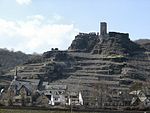
|
| Grenzau Castle | Höhr-Grenzhausen | Isenburg-Grenzau | around 1210 | Castle ruins |

|
| Arenfels Castle | Bad Hönningen | Isenburg-Arenfels | 13th Century | preserved, substantially rebuilt from 1849 to 1855 |
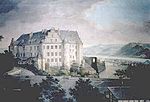
|
| Limburg Castle | Limburg on the Lahn | Isenburg-Limburg | around 800 | largely preserved |
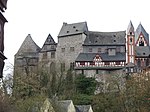
|
| Büdingen Castle | Büdingen | Ysenburg-Büdingen-Büdingen | 12th Century | preserved, residence on the Ysenburg-Büdingen line |

|
| Ronneburg Castle | Ronneburg - Altwiedermus | Isenburg-Ronneburg | 13th Century | largely preserved |
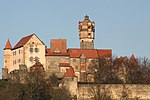
|
| Birstein Castle | Birstein | Isenburg-Birstein | 12th century, residence since 1517 | Preserved, residence of the Isenburg-Birstein line |
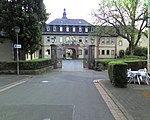
|
| Isenburg Castle in Offenbach | Offenbach am Main | Isenburg-Offenbach | 16th Century | Use by the Offenbach am Main University of Design |

|
| Marienborn Castle | Büdingen - Eckhartshausen | Ysenburg-Büdingen-Marienborn | 1687 | canceled |

|
| Meerholz Castle | Gelnhausen - Meerholz | Ysenburg-Büdingen-Meerholz | 1555/64 | Inner Mission Nursing Home |

|
| Wächtersbach Castle | Waechtersbach | Ysenburg-Büdingen-Wächtersbach | medieval moated castle, residence from 1687 | Seat of the city administration of Wächtersbach |

|
| Philippseich Castle | Dreieich - Götzenhain | Isenburg-Philippseich | Hunting lodge from 1675, today's palace building 1794–1800 | Privately owned |

|
Of the numerous former Isenburg residences, Birstein Castle is still owned by the Catholic Isenburg (-Birstein) line, and Büdingen Castle and Ronneburg are owned by the Ysenburg-Büdingen Evangelical line.
coat of arms
The Isenburg family originally had the following coat of arms: Two red bars in silver . This was later continued by the Nieder-Isenburg lines. The Wetterauischen or Ober-Isenburg lines used in contrast: Two black bars in silver . This coat of arms was sometimes used with various heart shields .
The Isenburg coat of arms still appears in both colors today in a number of current municipal coats of arms, e.g. B .:
Web links
- “The history of Grenzau Castle” at Westerwald-Verein Höhr-Grenzhausen
- “Palaces and castles of the counties Isenburg / Ysenburg” at gudrun-kauck.de
literature
- Klaus-Peter Decker: County Isenburg-Büdingen. In: Winfried Speitkamp (ed.): Knights, Counts and Princes - secular dominions in the Hessian area approx. 900-1806. Marburg 2014, ISBN 978-3-942225-17-5 (= Handbook of Hessian History 3 = Publications of the Historical Commission for Hesse 63), pp. 232–272.
- Hellmuth Gensicke : State history of the Westerwald . 3. Edition. Historical Commission for Nassau, Wiesbaden 1999, ISBN 3-922244-80-7 .
- Gerhard Köbler : Historical lexicon of the German countries. The German territories from the Middle Ages to the present. 7th, fully edit. Ed., Beck, Munich 2007, ISBN 3-406-54986-1 , p. 311 ff. ( Limited preview on Google books )
- Hans Philippi : Territorial history of the county of Büdingen. Elwert, Marburg 1954 ( publications of the Hessian office for historical regional studies 23 ).
- Dagmar Reimers: Isenburg. In: New German Biography (NDB). Volume 10, Duncker & Humblot, Berlin 1974, ISBN 3-428-00191-5 , pp. 192-194 ( digitized version ).
Individual evidence
- ↑ For the spelling of the names of the various counts and princely houses s. Anton Calaminus The introduction of the Reformation in the county of Ysenburg . In: Journal of the Association for Hessian History and Regional Studies, Volume 9, Kassel 1862, pp. 1–57.
- ↑ a b "On the history of Isenburg" at bendorf-geschichte.de
- ↑ Arthur B. Schmidt: The historical foundations of civil law in the Grand Duchy of Hesse . Curt von Münchow, Giessen 1893, p. 105 u. Note 25 and attached map.
- ^ Gustav Simon : The history of the imperial house Ysenburg and Büdingen, second volume: The Ysenburg and Büdingen'sche house history, Frankfurt, Brönner, 1865, p. 363 f.
- ^ Johann Daniel Albrecht Hoeck : Historical-statistical topography of the county of Oberisenburg , Jäger, Frankfurt am Main, 1790, p. 99 ( Memento from March 29, 2016 in the Internet Archive )
- ↑ At a banquet with several diplomats from German imperial territories, Foreign Minister Talleyrand is said to have informed them of Napoleon's order: "Everything has already been negotiated with Bavaria and Württemberg, so the other sovereigns have no choice but to join in if they want to keep their countries", Envoy von Beust from Paris to his sovereign, the Elector of Mainz Karl Theodor von Dalberg on 3rd / 4th. July 1806; BStA (Bavarian State Archives) Würzburg, MGK 494, 3, fol. 138-143, quoted from: Konrad M. Färber Kaiser and Arch Chancellor - Carl von Dalberg and Napoleon , Mittelbayerische Druck- und Verlags-Gesellschaft (also University of Munich, dissertation 1982), Regensburg 1994, p. 93 [186], ISBN 3927529516
- ↑ Article 24, paragraph 11 of the Rhine Confederation Act ( official: contract between the Plenipotentiary Sr. Majesty of the Emperor of the French, King of Italy, and the Plenipotentiaries of German Princes named in the treaty dated July 12, 1806. Status: May 25, 2013 )
- ^ Convention Territorial entre le Grand Duc de Hesse et Electeur de Hesse . - Signèe à Francfort sur Mein, le 29 Juin, 1816. British and Foreign State Papers 1815-1816, Volume 3, Compiled by the Librarian and Keeper of the Papers, Foreign Office, James Ridgway and Sons, Piccadilly, London: 1838, p 812-819; (mostly in German) digitized version
- ^ Gerhard Köbler : Historisches Lexikon der deutschen Lander , p. 312.
- ^ Rembold von Isenburg at genealogy.eu
- ^ [1] Ferdinand Maximilian Prince of Ysenburg and Büdingen in Wächtersbach
- ↑ "The coat of arms of the House of Isenburg" at welt-der-wappen.de








